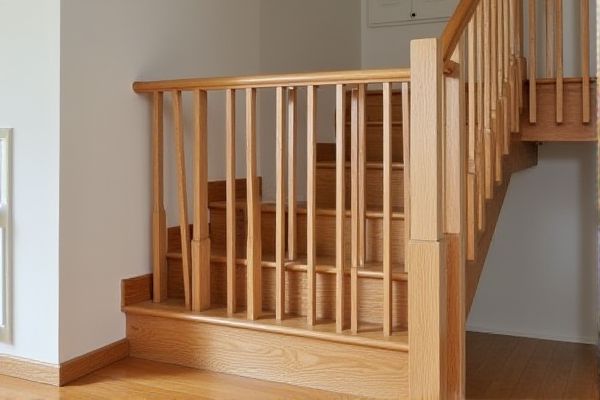
Oak rail offers superior durability and a rich, natural grain that enhances the aesthetic appeal of your fence or furniture, while pine rail is more affordable and easier to work with but less resistant to wear and weathering. Discover which wood choice best suits your project's needs by reading the rest of the article.
Table of Comparison
| Feature | Oak Rail | Pine Rail |
|---|---|---|
| Durability | High, resistant to wear and decay | Moderate, less resistant to impact and moisture |
| Strength | Strong, supports heavy loads | Weaker, suitable for lighter applications |
| Grain & Appearance | Distinct, coarse grain with rich color | Fine, uniform grain, lighter color |
| Cost | Higher, due to quality and durability | Lower, more affordable option |
| Workability | Harder to cut and shape | Easy to work with and shape |
| Common Uses | Furniture, flooring, heavy-duty rails | Interior trim, framing, decorative rails |
Introduction to Oak Rail vs Pine Rail
Oak rail offers superior durability and strength compared to pine rail, making it ideal for heavy-use applications and outdoor environments. Pine rail is more affordable and easier to work with due to its softer texture, but it may require more maintenance over time. Your choice depends on balancing budget constraints with the desired longevity and appearance of the railing.
Key Differences Between Oak and Pine Rail
Oak rails offer superior durability, hardness, and resistance to wear compared to pine rails, making them ideal for high-traffic or outdoor use. Pine rails are lighter, more affordable, and easier to work with, but they are softer and more prone to dents and scratches. The natural grain and rich color of oak provide a premium aesthetic, while pine's lighter tone suits rustic or casual designs, highlighting their key differences in strength, cost, and visual appeal.
Durability Comparison: Oak Rail vs Pine Rail
Oak rails exhibit significantly greater durability compared to pine rails due to their dense hardwood structure, which resists wear, rot, and insect damage more effectively. Pine rails, being softer and less dense, are more prone to dents, scratches, and weather-related deterioration, reducing their lifespan in outdoor applications. For long-lasting fence or railing projects exposed to harsh conditions, oak rails offer superior performance and lower maintenance requirements.
Cost Analysis: Oak Rail vs Pine Rail
Oak rail typically costs more than pine rail due to its durability and hardwood quality, making it a long-term investment for your project. Pine rail offers a budget-friendly alternative with softer wood, which may require more maintenance and replacement over time. When considering cost efficiency, evaluating the initial expense against potential longevity and upkeep helps determine the best rail option for your needs.
Aesthetic Appeal: Grain and Color Differences
Oak rails offer a rich, pronounced grain pattern with warm, reddish-brown hues that enhance rustic or traditional aesthetics, while pine rails display a lighter, softer grain with pale yellow tones ideal for casual or coastal designs. The distinct grain texture of oak creates a more textured and visually striking surface compared to the smoother, more uniform appearance of pine. Your choice between oak and pine rails will heavily influence the overall ambiance and visual impact of your woodworking or furniture project.
Installation Process and Ease
Oak rail installation tends to be more labor-intensive due to its density and hardness, requiring pre-drilling and sturdier fastening methods to prevent splitting. Pine rail is easier to handle with softer wood allowing for quicker cutting, shaping, and nailing without heavy-duty tools. The lighter weight and flexibility of pine rails generally result in faster installation times compared to the more rigid and heavy oak rails.
Maintenance Requirements for Oak and Pine Rails
Oak rails demand less frequent maintenance due to their dense grain and natural resistance to rot, insects, and weathering, making them a durable choice for outdoor use. Pine rails require more regular treatment with sealants or preservatives to prevent decay and extend their lifespan, especially in harsh climates. Consistent upkeep of pine involves sanding and re-staining every few years, whereas oak rails typically need only occasional inspections and minor touch-ups.
Environmental Impact and Sustainability
Oak rail offers greater durability and longevity compared to pine rail, reducing the need for frequent replacements and minimizing environmental waste. Pine rail, being a fast-growing softwood, supports sustainable forestry practices and has a lower initial carbon footprint due to quicker regeneration cycles. Choosing oak or pine rail can influence your overall environmental impact by balancing between resource renewal rates and product lifespan.
Common Applications: Where Each Excels
Oak rail excels in applications requiring superior durability and aesthetic appeal, making it ideal for high-traffic areas such as staircases, furniture frames, and outdoor decking. Pine rail is favored for projects where cost-effectiveness and ease of workability are priorities, such as interior trim, temporary railings, and lightweight furniture. Understanding the specific demands of your project helps determine whether the strength of oak or the affordability of pine rail is the best fit.
Choosing the Right Rail: Factors to Consider
Oak rail offers superior strength and durability, making it ideal for heavy-duty applications and long-term use, while pine rail is lighter, more affordable, and easier to work with, suitable for projects with budget or weight constraints. Your choice should consider factors such as environmental exposure, load-bearing requirements, and maintenance preferences to ensure optimal performance. Selecting the right rail material impacts the longevity and functionality of your structure, balancing cost with strength and aesthetic needs.
 homyna.com
homyna.com